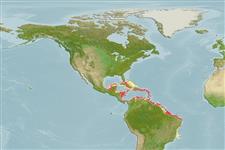>
Carangaria/misc (Various families in series Carangaria) >
Centropomidae (Snooks)
Etymology: Centropomus: Greek, kentron = sting + Greek, poma, -atos = cover, operculum (Ref. 45335).
More on author: Poey.
Environment: milieu / climate zone / depth range / distribution range
Ecologia
marino; acqua dolce; salmastro benthopelagico; amfidromo (Ref. 51243); distribuzione batimetrica ? - 22 m (Ref. 26912). Subtropical; 25°N - 23°S, 98°W - 34°W
Western Atlantic: southern Florida (USA), Greater and Lesser Antilles, and continental Caribbean coasts of Central and South America southward extending to Rio de Janeiro, Brazil.
Size / Peso / Age
Maturity: Lm ? range ? - ? cm
Max length : 36.2 cm TL maschio/sesso non determinato; (Ref. 40637); common length : 25.0 cm TL maschio/sesso non determinato; (Ref. 5217); peso massimo pubblicato: 1.0 kg (Ref. 5217)
Spine dorsali (totale): 8 - 9; Raggi dorsali molli (totale): 10; Spine anali 1-3; Raggi anali molli: 6. 2nd spine of anal fin greatly enlarged; body yellowish brown dorsally, silver laterally and ventrally; lateral line dusky; pectoral and pelvic fins yellow, other fins dusky (Ref. 13608).
Inhabits coastal waters, estuaries and lagoons, penetrating into freshwater; usually prefers very low brackish water or freshwater. Found over soft bottoms (Ref. 5217). Feeds on small fishes (Engraulidae, Clupeidae, etc.) and crustaceans (mainly shrimps) (Ref. 35237).
Juveniles in mangrove areas and irrigation canals.
Fraser, T.H., 1978. Centropomidae. In W. Fischer (ed.) FAO species identification sheets for fishery purposes. West Atlantic (Fishing Area 31). FAO, Rome. Vol. 1-2. pag.var. (Ref. 3713)
IUCN Red List Status (Ref. 130435)
Threat to humans
Harmless
Human uses
Pesca: scarso interesse commerciale
Informazioni ulteriori
BibliografiaAcquacolturaProfilo di acquacolturaVarietàGeneticaElectrophoresesEreditarietàMalattieElaborazioneNutrientsMass conversion
Strumenti
Special reports
Download XML
Fonti Internet
Estimates based on models
Preferred temperature (Ref.
123201): 26.8 - 28.3, mean 27.5 °C (based on 517 cells).
Phylogenetic diversity index (Ref.
82804): PD
50 = 0.5005 [Uniqueness, from 0.5 = low to 2.0 = high].
Bayesian length-weight: a=0.00759 (0.00447 - 0.01286), b=3.08 (2.94 - 3.22), in cm total length, based on LWR estimates for this species & Genus-body shape (Ref.
93245).
Trophic level (Ref.
69278): 4.2 ±0.62 se; based on food items.
Resilienza (Ref.
120179): Medio, tempo minimo di raddoppiamento della popolazione 1.4 - 4.4 anni (tm=3-4; Fec=80,000).
Fishing Vulnerability (Ref.
59153): Low to moderate vulnerability (26 of 100).
Nutrients (Ref.
124155): Calcium = 58.7 [33.6, 120.4] mg/100g; Iron = 0.742 [0.452, 1.292] mg/100g; Protein = 19.3 [17.0, 21.5] %; Omega3 = 0.39 [0.18, 0.89] g/100g; Selenium = 17.8 [9.1, 32.5] μg/100g; VitaminA = 26.9 [9.7, 79.2] μg/100g; Zinc = 0.949 [0.660, 1.368] mg/100g (wet weight);
